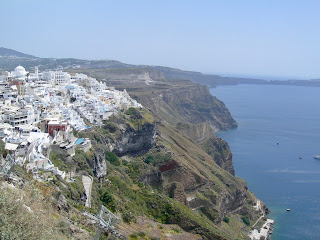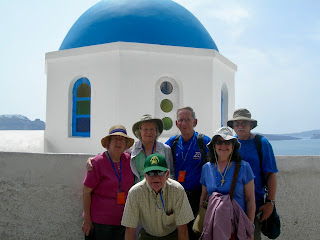On our third day sailing the Aegean we arrived at Santorini, one of the most beautiful islands in the world. Just prior to our departure from Athens we were informed that the scheduled visit to Knossos on the island of Crete had been cancelled due to the May Day holiday. The tour company offered a substitute: a full island tour of Santorini (ancient Thera). This was a real plus for me. I first visited Santorini in 2001, and like most of the 1.5 million tourists annually, I only visited the much photographed capital of Fira high upon the cliffs overlooking the Caldera. Now, I would be able to see the whole island, including Akrotiri, one the most important prehistoric settlements of the Aegean. The first inhabitants of Akrotiri date from Neolithic times—4000-3000 B.C.
Santorini is the site of one of the largest volcanic eruptions in recorded history (the Minoan eruption) which occurred some 3,600 years ago at the height of the Minoan civilization. The eruption left a large water-filled Caldera (a volcano crater formed when the mouth of the volcano collapses) and may have led indirectly to the destruction of the Minoan civilization (Knossos and other palace sites) on the island of Crete through a giant tsunami.
A tender boat took us from our yacht to the island. There are three ways to get to the top of the 980 foot cliff and Fira Town. You can take the cable car, you can walk (climb) or you can ride up on a donkey. We went up by cable car and then toured the island by bus. (I wondered how the bus got up the 980 foot cliff—by cable car, driven, or on the back of a donkey!) The cliff is not the only access to the island, though many tourists think so.
Excavation at Akrotiri (sometimes referred to as the Pompeii of the Aegean) began in 1967. A Minoan town was uncovered. Three-story buildings with stone staircases still intact, streets, workshops, a highly developed drainage system, pipes with running water (both hot, probably geothermic, and cold) water closets (the oldest ever discovered) beds and bathtubs were found under the layers of volcanic ash. An amazing discovery of a highly advanced and sophisticated people. No human skeletal remains were found which suggest the citizens escaped the great Minoan eruption. I wonder where they went?




No comments:
Post a Comment